 . What would you respond with hands a), b), and c)?
. What would you respond with hands a), b), and c)?
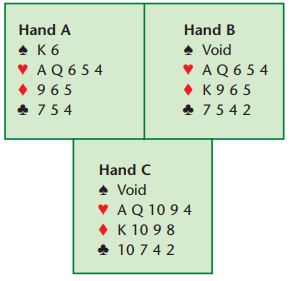 In each case your choices are 2
In each case your choices are 2 . If I respond 2
. If I respond 2 on as poor a suit as
on as poor a suit as  A-J-4-3-2. I would have to pass this. It seems to me that we have the majority of points and it would not be sensible to leave him in a spade contract with a trump suit of
A-J-4-3-2. I would have to pass this. It seems to me that we have the majority of points and it would not be sensible to leave him in a spade contract with a trump suit of  A-J-4-3-2 opposite a void or singleton.
If I respond 1NT, I am not forcing him to bid again. If he chooses to rebid 2
A-J-4-3-2 opposite a void or singleton.
If I respond 1NT, I am not forcing him to bid again. If he chooses to rebid 2 he will have at least a six-card suit. With a misfitting 9 points I would do better to keep the bidding low and give him an opportunity to pass. A 2
he will have at least a six-card suit. With a misfitting 9 points I would do better to keep the bidding low and give him an opportunity to pass. A 2 , I can pass with a clear conscience. If I respond 2
, I can pass with a clear conscience. If I respond 2 . It is better to respond 1NT, keeping the bidding low on a misfit.
However, suppose he rebids 2
. It is better to respond 1NT, keeping the bidding low on a misfit.
However, suppose he rebids 2 . I have responded 2
. I have responded 2Opener also should be constantly re-evaluating his assets. You open 1Principle 1: With a misfit, keep the bidding low. Prefer a bid that allows partner to pass to a bid that makes him rebid.
Principle 2: With 9 points and a singleton or void in partner’s suit, don’t change suit at the two level and then pass when he rebids his suit.
 with the West hand in Layouts 1 and 2. Perhaps you regard the hand as borderline between rebidding 2
with the West hand in Layouts 1 and 2. Perhaps you regard the hand as borderline between rebidding 2 and 3
and 3 . Your fit (or misfit) with partner’s response should help you decide.
. Your fit (or misfit) with partner’s response should help you decide.
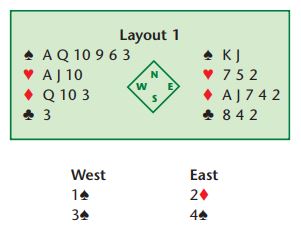 Note how snugly West’s diamond holding fits with East in Layout 1. If the diamond finesse works, declarer may make twelve tricks.
Note how snugly West’s diamond holding fits with East in Layout 1. If the diamond finesse works, declarer may make twelve tricks.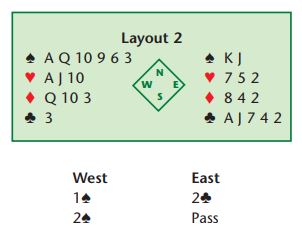 In Layout 2, 2
In Layout 2, 2 is quite high enough! Note that West’s level of rebid was influenced by how well his honour cards fitted partner’s suit. We can talk about a fit even if we are not sure it is an eight-card fit, and even if we have no intention of making the suit trumps.
is quite high enough! Note that West’s level of rebid was influenced by how well his honour cards fitted partner’s suit. We can talk about a fit even if we are not sure it is an eight-card fit, and even if we have no intention of making the suit trumps.
Principle: With honour cards and some length in partner’s suit, upgrade your hand. With shortage in partner’s suit, downgrade your hand.It is worth noting that if partner has a minimum two-level response he should have honour cards in the suit. With a poor suit and only 9 points he should prefer a 1NT response. Note, also, that three small cards in partner’s suit is not particularly attractive:
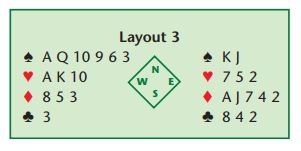 Game is playable but if the defenders get round to attacking hearts early 4
Game is playable but if the defenders get round to attacking hearts early 4 is not a good contract.
is not a good contract.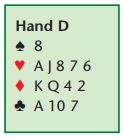 The ability to keep the bidding low with misfits is an easy source of good scores for experienced players. Holding Hand D, you open 1
The ability to keep the bidding low with misfits is an easy source of good scores for experienced players. Holding Hand D, you open 1 , you rebid 2
, you rebid 2 . What do you do now?
At club level 2NT would be the common, but very ill-advised choice. The argument would be: ‘He guards the spades: I guard the other three suits’. Perhaps, but to play in no-trumps you need to make tricks, not just stop your opponents making them. 2
. What do you do now?
At club level 2NT would be the common, but very ill-advised choice. The argument would be: ‘He guards the spades: I guard the other three suits’. Perhaps, but to play in no-trumps you need to make tricks, not just stop your opponents making them. 2 shows a weak hand with a goodish six-card suit. You can almost envisage layout 4:
shows a weak hand with a goodish six-card suit. You can almost envisage layout 4: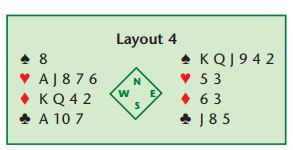 What is the correct contract in Layout 4? Clearly 2
What is the correct contract in Layout 4? Clearly 2 ! No-trump contracts have no chance whatsoever because there is no entry to East’s spades. West must pass 2
! No-trump contracts have no chance whatsoever because there is no entry to East’s spades. West must pass 2 !
!
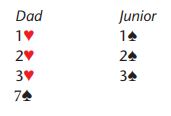 Opponents doubled and Junior was furious, demanding an explanation from Dad. Dad was exceedingly laid back, answering: ‘I thought 7
Opponents doubled and Junior was furious, demanding an explanation from Dad. Dad was exceedingly laid back, answering: ‘I thought 7 would save four rounds of bidding!’
would save four rounds of bidding!’ 
























